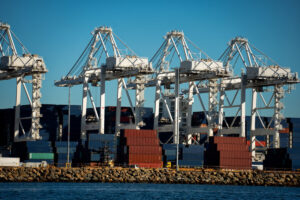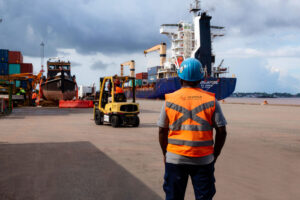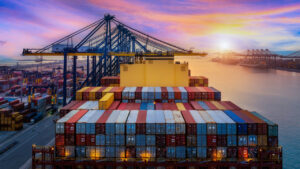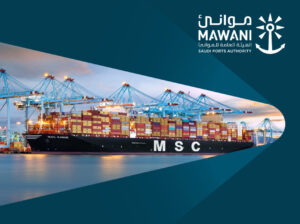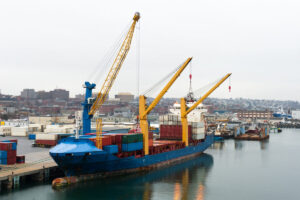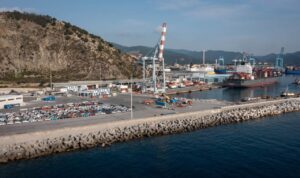In a recent webinar with Drewry Shipping Consultants, the maritime advisors answer questions based on spot rate volatility and the solutions available to overcome these issues.
What do you think will be the impact of ever bigger ships on spot rates?
The introduction of ever larger ships into a market that is already over supplied has had the effect of increasing rate volatility. The reason is that not only does the upscaling of vessels increase the capacity deployed but also there is the individual carrier behaviour, especially with this first wave of record ships, where shipping lines don’t want to have the ship sail half empty on its maiden voyage. So on top of the structural effect of increasing supply, we’ve noticed the very short term effect of carriers grabbing extra cargo to assure the ship is nicely full and the only way to do so is by dropping the rates.
With the prospect of new ULCV’s entering the trade with a rate of 1 per week between now and the end of the year, we expect freight rate volatility to increase further.
We’ve struggled to effectively deal with freight rate volatility and it remains a real issue for our organisation. How can we deal with this
That’s a question we receive regularly and is in fact a very pertinent question, especially because freight rate volatility, in the face of increasing overcapacity in the coming years, is likely to get worse.
The first option is to work with long term contracts. These are pretty standard for medium and large BCO and most of them do this for the majority of their cargo. In theory, this way of working offers the advantage of relative price stability and allows the parties to focus on service aspects rather than rates.
However in reality, we see quite often that the pressures from the spot market can put a strain on the contractual relationship. For example, as we’ve seen on Asia-Europe recently, the pressure to leave the contracts grow rapidly when spot rates are below the contract rates by a significant amount and for a considerable period of time.
Alternatively, when the spot rates are higher than the contract rates, the shipping lines have an incentive to give priority to higher paying spot cargo. On the one hand you may think that that situation is not likely to occur in the present scenario, and you are right, we are quite far away from a situation where a carrier can pick and choose the cargo it takes on board. On the other hand, if the July 1 GRI fails, shipping lines are likely to resort to more drastic capacity reductions than blanking some sailings and when that happens, spot rates can increase very suddenly and unexpectedly.
What do you expect to happen with Asia-Europe rates in the near future?
We believe that our index for Asia-Europe rates will increase during July and August on the back of GRI’s that will be partially successful due to the coinciding of peak season volumes with artificial reductions in capacity through blanked sailings. We’ve seen that the mid-May GRI managed to increase the index for the month and we believe the GRI’s that are announced for July 1 and August 1 will have a similar effect of jerking up the rates spectacularly for one week and after that week, the rates collapse again, but the monthly average gradually moves up. Obviously a lot will depend on size of the demand peak.
We believe that more drastic measures to reduce supply are required for rates to stabilise at sustainable levels however these have so far not been announced. So in order to judge the extent to which the GRI’s will be successful, we’ll have to keep a close eye on the demand side developments. Currently, we have no information pointing towards an extremely successful peak season.
Are alliances a solution for reducing over capacity
Alliances are a solution for sharing the commercial risk of operating a string of Ultra Large Container Vessels ULCVs. ULCVs were a solution for improving the operating cost in a commoditised market: when customers select providers solely based on price, it’s the shipping line with the best cost profile that can offer the best prices to its customers and gain market share or generate superior profits.
So alliances were put in place to operate the ULCVs but do not contribute to reducing capacity. If anything, they’ve contributed to increasing capacity by improving the operability of ULCV’s.
Do you expect any space issues in the near future?
Currently the idle vessel fleet is very low and so are scrapping volumes, so shipping lines have recently only used blank sailings to reduce capacity. This signals that in general, it’s been cheaper to operate the ship, even at a loss, than to lay it up completely.
Pulling a service also has negative commercial repercussions and no shipping line will want to be seen by the market as a first mover in this regard. All of that will change if the poor rate situation continues to deteriorate and laying up vessels becomes the cheapest option for shipping lines as we have seen it happen in 2009.
Consequently Drewry believes that BCOs should be aware of the potential of space issues should carriers be forced to withdraw services to support rates – O3 Alliance announced the temporary withdrawal of a complete Asia-Europe string yesterday, for example.
Why are the orders of new mega vessels rising? Will the ULCV ordering not cause a cascade effect and result in even bigger rate reductions, when the industry is already in an unsustainable position?
Ordering bigger ships is perfectly rational from an individual carrier’s perspective: in a commoditised market the objective is to achieve the lowest possible operating cost. This can be achieved by using the scale economies offered by these bigger ships.
In a process that is called vessel upscaling, shipping lines maintain existing service patterns but they are being performed with bigger ships. The ships that have become redundant in the process need a new home which is usually found by cascading them to secondary trades. These secondary trades then also experience vessel upscaling and further cascading follows.
Currently, all the mega-alliances engage in upscaling. Capacity is being injected into a market that is already oversupplied and at the same time everyone is putting a brake on scrapping and layups. The result is dramatic over supply situation on all the trade routes and hence the crash in rates. For the next 2-3 years we do not see the situation improve.

